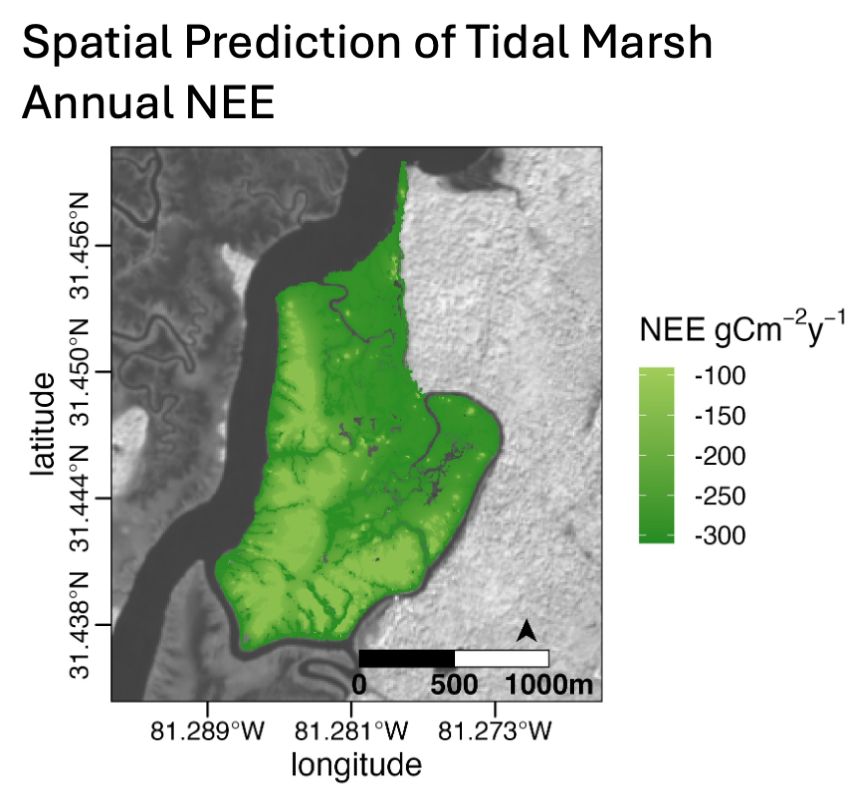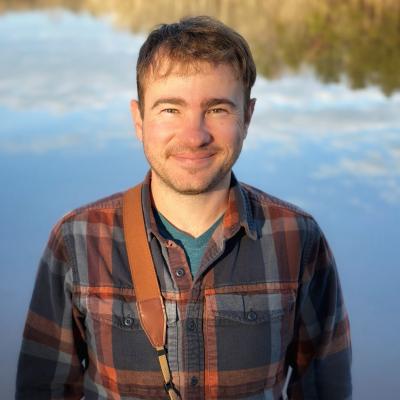Blue Carbon
Quantifying Tidal Wetland Blue Carbon from Field to Space

We investigate the dynamics of carbon (C) exchange and storage in coastal tidal wetlands across the eastern United States. Our specialties are exploring the spatiotemporal drivers of C variability and scaling-up C fluxes using remote sensing techniques. We maintain eddy covariance flux towers in tidal marshes in Georgia (AmeriFlux ID: US-GCE) and Mississippi. Each tower measures vertical carbon fluxes of net ecosystem exchange (NEE) which can then be partitioned into ecosystem respiration (Re) and gross primary production (GPP). Additionally, we conduct extensive fieldwork sampling marsh biomass, canopy structure, and soil C.
Our upcoming research will explore the lateral exchange of C in these tidally influenced ecosystems. We will focus on quantifying the inorganic CO2 dissolved in tidal flood waters as they flood and ebb across the marsh surface. This will allow us to better understand the impact CO2 rich flood waters have on our vertical C flux measurements. This new research will also provide valuable insight into determining tidal marsh net ecosystem carbon balance (NECB) – the net C balance between vertical and lateral fluxes.
Publications:
-
Hawman, P. A., Mishra, D. R., O’Connell, J. L., Cotten, D. L., Narron, C. R., & Mao, L. (2021). Salt Marsh Light Use Efficiency is Driven by Environmental Gradients and Species‐Specific Physiology and Morphology. Journal of Geophysical Research: Biogeosciences, 126(5). https://doi.org/10.1029/2020JG006213
-
Hawman, P. A., Mishra, D. R., & O’Connell, J. L. (2023). Dynamic emergent leaf area in tidal wetlands: Implications for satellite-derived regional and global blue carbon estimates. Remote Sensing of Environment, 290, 113553. https://doi.org/10.1016/j.rse.2023.113553
-
Hawman, P. A., Cotten, D. L., & Mishra, D. R. (2024). Canopy Heterogeneity and Environmental Variability Drive Annual Budgets of Net Ecosystem Carbon Exchange in a Tidal Marsh. Journal of Geophysical Research: Biogeosciences, 129(4), e2023JG007866. https://doi.org/10.1029/2023JG007866
-
Mao, L., Mishra, D. R., Hawman, P. A., Narron, C. R., O’Connell, J. L., & Cotten, D. L. (2023). Photosynthetic Performance of Tidally Flooded Spartina alterniflora Salt Marshes. Journal of Geophysical Research: Biogeosciences. https://doi.org/10.1029/2022JG007161
-
Sharma, R., Mishra, D. R., Levi, M. R., & Sutter, L. A. (2022). Remote Sensing of Surface and Subsurface Soil Organic Carbon in Tidal Wetlands: A Review and Ideas for Future Research. Remote Sensing, 14(12), 2940. https://doi.org/10.3390/rs14122940
Funding and Collaborators:
-
NASA (Carbon Cycle Science #NNX17AI76G)
-
NSF (Georgia Coastal Ecosystems LTER OCE1237140 and OCE1832178)
-
UGA Marine Institute
-
Grand Bay National Estuarine Research Reserve
-
University of Southern Mississippi
